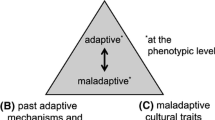Abstract
Fertility decline is a great challenge to evolutionary approaches to human behavior. In this study, we apply the perspective of sexual conflict between mother and father to the fertility decline. We predict that, under serial monogamy allowing for mate changes, the ideal number of children for women should be smaller than that for men, because the cost of reproduction for women should be higher than that for men. Our reasoning is that if the cost of child-bearing and child-rearing is higher for women than men, and if women, who therefore would want a smaller number of children than their husbands, have gained more power in reproductive decision-making within a couple owing to the modernization of society, fertility should decline. Until now, few evolutionary studies have analyzed empirical data in modern developed societies with such a perspective. Our questionnaire survey in an urban area in Japan revealed that mothers did experience greater cost during childcare than fathers. However, in contrast to our prediction, we found no sex differences in the ideal number of children between mothers and their husbands in many cases. About 60% of parents remembered wanting two children when they were childless. Moreover, mothers and their husbands had equal power in their decision-making regarding having children. After presenting these results, we discuss some perspectives to advance our understanding of fertility decline in terms of sexual conflict.





Similar content being viewed by others
References
Alvergne, A., & Lummaa, V. (2014). Ecological variation in wealth-fertility relationships in Mongolia: the ‘central theoretical problem of sociobiology’ not a problem after all? Proceedings of the Royal Society B: Biological Sciences, 281, 20141733.
Alvergne, A., Lawson, D. W., Clarke, P. M. R., Gurmu, E., & Mace, R. (2013). Fertility, parental investment, and the early adoption of modern contraception in rural Ethiopia. American Journal of Human Biology, 25, 107–115.
Arnqvist, G., & Rowe, L. (2005a). Sexual conflict. Princeton: Princeton University Press.
Arnqvist, G., & Rowe, L. (2005b). Parental care and sexual conflict. In G. Arnqvist & L. Rowe (Eds.), Sexual conflict (pp. 156–178). Princeton: Princeton University Press.
Bankole, A., & Singh, S. (1998). Couples’ fertility and contraceptive decision-making in developing countries: hearing the man’s voice. International Family Planning Perspectives, 24, 15–24.
Barkow, J. H., & Burley, N. (1980). Human fertility, evolutionary biology, and the demographic transition. Ethology and Sociobiology, 1, 163–180.
Bolund, E., Bouwhuis, S., Pettay, J. E., & Lummaa, V. (2013). Divergent selection on, but not genetic conflict over, female and male timing and rate of reproduction in human population. Proceedings of the Royal Society B: Biological Sciences, 280, 20132002.
Borgerhoff Mulder, M. (1998). The demographic transition: are we any closer to an evolutionary explanation? Trends in Ecology and Evolution, 13, 266–270.
Borgerhoff Mulder, M. (2009a). Tradeoffs and sexual conflict over women’s fertility preferences in Mpimbwe. American Journal of Human Biology, 21, 478–487.
Borgerhoff Mulder, M. (2009b). Serial monogamy as polygyny or polyandry? Marriage in the Tanzanian Pimbwe. Human Nature, 20, 130–150.
Borgerhoff Mulder, M., & Rauch, K. L. (2009). Sexual conflict in humans: variations and solutions. Evolutionary Anthropology, 18, 201–214.
Brown, G. R., Laland, K. N., & Borgerhoff Mulder, M. (2009). Bateman’s principles and human sex roles. Trends in Ecology and Evolution, 24, 297–304.
Burbank, V., & Chisholm, J. S. (1992). Gender differences in the perception of ideal family size in an Australian Aboriginal community. In B. S. Hewlett (Ed.), Father-child relations: Cultural and biosocial contexts (pp. 177–190). New York: Aldine de Gruyter.
Carey, A. D., & Lopreato, J. (1995). The evolutionary demography of the fertility-mortality quasi-equilibrium. Population and Development Review, 21, 613–630.
Chapman, T., Arnqvist, G., Bangham, J., & Rowe, L. (2003). Sexual conflict. Trends in Ecology and Evolution, 18, 41–47.
Colleran, H., & Mace, R. (2015). Social network- and community-level influences on contraceptive use: evidence from rural Poland. Proceedings of the Royal Society B: Biological Sciences, 282, 20150398.
Colleran, H., Jasienska, G., Nenko, I., Galbarczyk, A., & Mace, R. (2014). Community-level education accelerates the cultural evolution of fertility decline. Proceedings of the Royal Society B: Biological Sciences, 281, 20132732.
Dodoo, F. N. A., & Seal, A. (1994). Explaining spousal differences in reproductive preferences: a gender inequality approach. Population and Environment, 15, 379–394.
Goodman, A., Koupil, I., & Lawson, D. W. (2012). Low fertility increases descendant socioeconomic position but reduces long-term fitness in a modern post-industrial society. Proceedings of the Royal Society B: Biological Sciences, 279, 4342–4351.
Gowaty, P. A., Kim, Y. K., & Anderson, W. W. (2012). No evidence of sexual selection in a repetition of Bateman’s classic study of Drosophila melanogaster. Proceedings of the National Academy of Sciences of the United States of America, 109, 11740–11745.
Hill, S. E., & Reeve, H. K. (2005). Low fertility in humans as the evolutionary outcome of snowballing resource games. Behavioral Ecology, 16, 398–402.
Holm, S. (1979). A simple sequentially rejective multiple test procedure. Scandinavian Journal of Statistics, 6, 65–70.
Ihara, Y. (2008). Spread of costly prestige-seeking behavior by social learning. Theoretical Population Biology, 73, 148–157.
Jokela, M., Rotkirch, A., Rickard, I. J., Pettay, J., & Lummaa, V. (2010). Serial monogamy increases reproductive success in men but not in women. Behavioral Ecology, 21, 906–912.
Jones, J. H., & Bird, R. B. (2014). The marginal valuation of fertility. Evolution and Human Behavior, 35, 65–71.
Kamiya, T. (2010). Marital relationships and their financial management in the household economy. Annual Bulletin, Graduate School of Education, Tohoku University, 58, 135–151 (in Japanese).
Kaplan, H. S., & Lancaster, J. B. (2000). The evolutionary economics and psychology of the demographic transition to low fertility. In L. Cronk, N. Chagnon, & W. Irons (Eds.), Adaptation and human behavior: An anthropological perspective (pp. 283–322). New York: Aldine de Gruyter.
Kaplan, H. S., & Lancaster, J. B. (2003). An evolutionary and ecological analysis of human fertility, mating patterns, and parental investment. In K. W. Wachter & R. A. Bulatao (Eds.), Offspring: Human fertility behavior in biodemographic perspective (pp. 170–223). Washington, DC: The National Academies Press.
Kaplan, H. S., Lancaster, J. B., Johnson, S. E., & Bock, J. A. (1995). Does observed fertility maximize fitness among New Mexican men? A test of an optimality model and a new theory of parental investment in the embodied capital of offspring. Human Nature, 6, 325–360.
Kokko, H., & Jennions, M. D. (2008). Parental investment, sexual selection and sex ratios. Journal of Evolutionary Biology, 21, 919–948.
Lawson, D. W., & Mace, R. (2011). Parental investment and the optimization of human family size. Philosophical Transactions of the Royal Society, B: Biological Sciences, 366, 333–343.
Lawson, D. W., Alvergne, A., & Gibson, M. A. (2012). The life-history trade-off between fertility and child survival. Proceedings of the Royal Society B: Biological Science, 279, 4755–4764.
Lopreato, J., & Yu, M. Y. (1988). Human fertility and fitness optimization. Ethology and Sociobiology, 9, 269–289.
Mace, R. (1996). When to have another babies: a dynamic model of reproductive decision-making and evidence from Gabbra pastoralists. Ethology and Sociobiology, 17, 263–273.
Mace, R. (2014). When not to have another baby: an evolutionary approach to low fertility. Demographic Research, 30, 1074–1096.
Mace, R., & Colleran, H. (2009). Kin influence on the decision to start using modern contraception: a longitudinal study from rural Gambia. American Journal of Human Biology, 21, 472–477.
Mason, K. O., & Taj, A. M. (1987). Differences between women’s and men’s reproductive goals in developing countries. Population and Development Review, 13, 611–638.
McAllister, L., Gurven, M., Kaplan, H., & Stieglitz, J. (2012). Why do women have more children than they want? Understanding differences in women’s ideal and actual family size in a natural fertility population. American Journal of Human Biology, 24, 786–799.
McDonald, P. (2000). Gender equity in theories of fertility transition. Population and Development Review, 26, 427–439.
Ministry of Health, Labour and Welfare. (2013). Special reports on the longitudinal survey of new borns in the 21st century and the longitudinal survey of adults in the 21st century: Ten-year follow up, 2001–2011. Tokyo: Health, Labour and Welfare Statistics Association (in Japanese).
Morita, M., Ohtsuki, H., Sasaki, A., & Hiraiwa-Hasegawa, M. (2012). Factors affecting the number of children in five developed countries: a statistical analysis with an evolutionary perspective. Letters on Evolutionary Behavioral Science, 3, 7–11.
Moya, C., Snopkowski, K., & Sear, R. (2016). What do men want? Re-examining whether men benefit from higher fertility than is optimal for women. Philosophical Transactions of the Royal Society B: Biological Sciences, 371, 20150149. (in press).
Penn, D. (1999). Explaining the human demographic transition. Trends in Ecology and Evolution, 14, 32.
Penn, D. J., & Smith, K. R. (2007). Differential fitness costs of reproduction between the sexes. Proceedings of the National Academy of Sciences of the United States of America, 104, 553–558.
Pettay, J. E., Rotkirch, A., Courtiol, A., Jokela, M., & Lummaa, V. (2014). Effects of remarriage after widowhood on long-term fitness in a monogamous historical human population. Behavioral Ecology and Sociobiology, 68, 135–143.
R Core Team. (2012). R: A language and environment for statistical computing. Vienna: R Foundation for Statistical Computing. ISBN 3-900051-07-0, URL http://www.R-project.org/.
Richerson, P. J., & Boyd, R. (2005). Not by genes alone: How culture transformed human evolution. Chicago: The University of Chicago Press.
Sear, R. (2015). Evolutionary contributions to the study of human fertility. Population Studies, 69, S39–S55.
Shackelford, T. K., & Goetz, A. T. (2012). The Oxford handbook of sexual conflict in humans. New York: Oxford University Press.
Shenk, M. K. (2009). Testing three evolutionary models of the demographic transition: patterns of fertility and age at marriage in urban south India. American Journal of Human Biology, 21, 505–511.
Shenk, M. K., Towner, M. C., Kress, H. C., & Alam, N. (2013). A model comparison approach shows stronger support for economic models of fertility decline. Proceedings of the National Academy of Sciences, 110, 8045–8050.
Skjærvø, G. R., & Røskaft, E. (2015). Wealth and the opportunity for sexual selection in men and women. Behavioral Ecology, 26, 444–451.
Snopkowski, K., & Kaplan, H. (2014). A synthetic biosocial model of fertility transition: testing the relative contribution of embodied capital theory, changing cultural norms, and women’s labor force participation. American Journal of Physical Anthropology, 154, 322–333.
Sobotka, T., & Beaujouan, É. (2014). Two is best? The persistence of a two-child family ideal in Europe. Population and Development Review, 40, 391–419.
Statistics and Information Department, Minister’s Secretariat, Ministry of Health, Labour and Welfare. (2011). Live births: Specified report of vital statistics in FY 2010. Tokyo: Health, Labour and Welfare Statistics Association.
Toulemon, L. (2011). Should governments in Europe be more aggressive in pushing for gender equality to raise fertility? The first “yes”. Demographic Research, 24, 179–200.
Trivers, R. (1972). Parental investment and sexual selection. In B. Campbell (Ed.), Sexual selection and the descent of man 1871–1971 (pp. 136–179). Chicago: Aldine.
Vining, D. R. (1986). Social versus reproductive success: the central theoretical problem of human sociobiology. Behavioral and Brain Sciences, 9, 167–187.
Acknowledgments
We would like to thank the staff at the study site as well as the parents, who kindly cooperated in our survey. Our deep thanks also go to the members of SOKENDAI on the Hayama campus for fruitful discussion and helpful advice. Valuable comments from the members of Evolutionary Demography Group at London School of Hygiene & Tropical Medicine, especially from Drs. Kristin Snopkowski, Cristina Moya, and Rebecca Sear, greatly improved this paper. We also thank three anonymous reviewers and the copy-editor for their helpful suggestions. This study was supported in part by JSPS/MEXT KAKENHI Grant Number 13J04635 (to MM), 25118006 (to HO).
Author information
Authors and Affiliations
Corresponding author
Rights and permissions
About this article
Cite this article
Morita, M., Ohtsuki, H. & Hiraiwa-Hasegawa, M. Does Sexual Conflict between Mother and Father Lead to Fertility Decline?. Hum Nat 27, 201–219 (2016). https://doi.org/10.1007/s12110-016-9254-y
Published:
Issue Date:
DOI: https://doi.org/10.1007/s12110-016-9254-y




